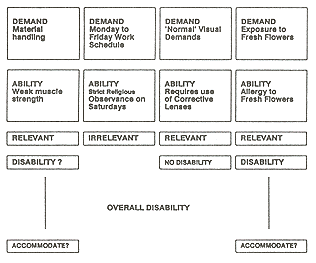
In the following example, the job vacancy was for a materials handler in a fresh flower warehouse. The demands of the employer are matched to the abilities of the candidate to determine if any relevant disabilities exist and whether they can be reasonably accommodated. 
Though the process seems overly complex for determining that someone with an allergy to fresh flowers should not be employed in a fresh flower warehouse, the example demonstrates aptly the difference between disabilities that may or may not be reasonably accommodated. It may have been possible to accommodate the lack of strength by utilizing a mechanical device and building up strength over time, but the allergy is a disability the employer is likely unable to reasonably accommodate. We next looked at some example of accommodations that might be considered in other situations. Accommodations: Types and Examples
Initial questions to ask might be: Where does the system have flexibility? Would machines be of assistance? Is the redesign of objects and furniture necessary? Can work organization and task allocation be changed? Can the job description itself be amended to reduce the demands? It is important to know that there are grants available to assist in these modification projects. The fact is, considering and implementing reasonable accommodation will broaden the scope of potential candidates at a time when the available labour pool is getting smaller. Businesses, to be successful, must attract and be able to adapt to a much more diverse population than has traditionally been utilized. Kathryn made that consideration seem appropriate, reasonable, and in everyone's best interest. Marcia Braundy is the guest editor of this issue of Women's Education des femmes. _________________________
|
| Back | Contents | Next |